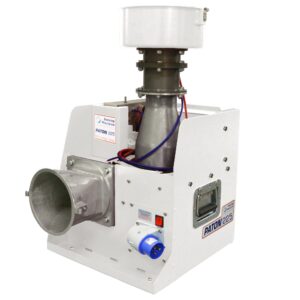Jul 27, 2023 |
Sensing Precision’s new Paton 225 is perfect for OEMs and test departments that don’t need the full function of the larger Paton machines, which incorporate smoke and heat generation and a PC-based controls system, and generally require more frequent calibration and maintenance. It is designed to test larger vehicles than the Paton 150, while maintaining the range’s simple control system and portable design. The Paton 225 should therefore be easier to justify as a first machine for new customers.
Like other Paton units, the Paton 225 uses three easy-to-change conical inlet nozzles designed to ISO5801, enabling the machine to cover a range of 1.5 l/s to 225 l/s. These precision-machined nozzles, combined with a recently enhanced control pod, give an accuracy of ±2% for the reading.
As standard the Paton 225 is supplied with two attenuators: one to clip to the inlet or outlet depending on whether the vehicle is being pressurized or depressurized, and one in-line with the hose that either supplies air to, or removes it from, the vehicle under test. These attenuators reduce the fan/airborne noise in both the test room and inside the vehicle, enabling the tester to listen for
leaks in the vehicle more easily as a supplementary way to identify any leakage paths.
The recently enhanced control pod for the portable Paton machines features additional low-range pressure cells for both pressure and flow measurement to increase low-end accuracy. There are also auto-zeroing solenoids on both channels to automatically nullify any temperature drift in the pressure readings without having to pause a running test or manually zero between tests. This
is particularly useful when outside temperatures vary significantly from inside the test room and roller doors in the test area are opened and closed regularly, or if the machine is moved to a different site. This new control pod is also standard on 2023 model year Paton 150 machines. The Paton 225 will sit between the Paton 150 and Paton 350 in the company’s product range, which is topped by the Paton 500. The model numbers refer to the maximum flow rate in liters per second at the industry standard ±250Pa, which most OEMs use to leakage test their vehicles. This means that the Paton 225 can deliver up to 225l/s at 250Pa.

The acceleration toward electric and green technologies in motor vehicles has created fresh challenges for vehicle designers and manufacturers. Reduced interior noise, extended glazed areas and now improved air quality, are pushing the envelope of test machinery, often requiring significant capital expenditure to find solutions. The addition of the Paton 225 to Sensing Precision’s range of leakage testers builds further on the heritage of the CAB leakage testers marketed under Sensing Precision’s previous brand, and has been added following customer feedback and site visits across several continents. It is optimally designed for R&D departments of large and small manufacturers alike. It augments product development and enables swift competitor evaluation while being equally suited to smaller production run vehicles as a quality control analysis tool for sample or full production assessment.
This piece was covered in the Automotive Testing Technology International June 2023 issue – Featuring NVH Leakage Testing: click here to view.
